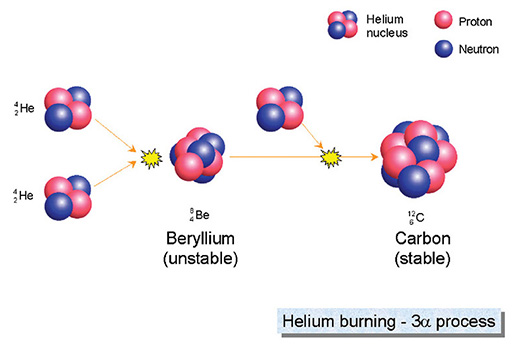1.1 Helium as a nuclear fuel
As a star approaches the end of its main sequence lifetime, the rate of energy production from hydrogen fusion in the core will begin to drop as the available hydrogen runs out. When this happens, the flow of energy will no longer be sufficient to support the star against gravity and the equilibrium will be lost.
Unless the star can find an alternative source of energy it would begin to collapse under the ever-present pull of gravity. In Activity 1 you will explore a potential source of energy that can – at least temporarily – replace the exhausted supply of hydrogen.
Activity 1 Helium fusion
During the time that a star spends on the main sequence, hydrogen fusion in the core converts hydrogen into helium. When the star reaches the end of its main sequence lifetime, the core will be rich in helium and low in hydrogen.
In this activity you will explore the possibility of helium fusion and the question of whether, and for how long, this might be able to replace the supply of energy needed to keep the star from collapsing under gravity.
We’ll start by looking at a nuclear reaction involving helium fusion:

In this process helium nuclei, also known as alpha particles (α-particles), fuse together to form heavier nuclei.
What is the overall effect of this triple alpha process? Think about what goes into the reaction and what comes out.
Answer
The overall effect is to convert three helium nuclei into one carbon nucleus, releasing energy in the process (as in the ppI chain, energy release is indicated by the yellow flashes). Each helium nucleus contains four particles – two neutrons and two protons. Three of these helium nuclei combine to form one carbon nucleus with six protons and six neutrons – a total of 12 particles.
Now think about the conditions required for this process to take place.
Based on what you learned earlier about the ppI chain, what conditions of temperature and pressure do you think will be required for this triple alpha process, compared to the conditions required for hydrogen fusion?
Answer
Each helium nucleus contains two positively charged protons, so these nuclei will repel each other much more strongly than the protons in the ppI chain. To force them together against this stronger repulsion requires higher temperatures and pressures than for hydrogen fusion. The core must be compressed and heated more than in a main sequence star for the triple alpha reactions to take place.
Finally, think about how long the energy produced by these reactions would last.
The triple alpha process releases far less energy than the hydrogen fusion of the ppI chain. Given that the mass of the core is the same, how long will the energy from helium fusion be able to support the star?
Answer
Since the energy produced is less, helium fusion will not be able to support the star for anywhere as long; this phase of a star’s life will be much shorter and less stable than the main sequence life of the star.
